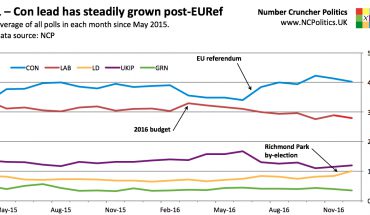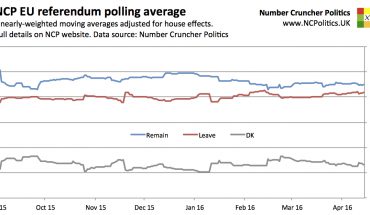After Lord Ashcroft's first look at Scotland, the second batch had a lot to live up to, but it certainly delivered in terms of information and astonishing swings. In this post I’ll take a look at his findings in Scottish seats (I’ll analyse the four non-Scottish seats separately). This batch focussed on areas that voted “no”, some of them heavily. But the pattern was very similar, with swings of at least 20% to the SNP in all but one of them.
The most astonishing of all was a swing of 28.5% in Kirkcaldy & Cowdenbeath where Gordon Brown is retiring, having won the seat by fifty points in 2010, but where his Labour successor is 6 points behind the nationalists. Also of note was Dumfries and Galloway, with the SNP demonstrating solid progress even in the South, relegating Labour to third place behind the Conservatives (all three parties were separated by 6 points on the second question and 4 on the first). Scottish Labour leader Jim Murphy leads by a point in Renfrewshire East, which has also become a relatively close three-way contest.
Overall, the Labour seats in these “No” areas show a remarkably similar pattern to those in Glasgow – the SNP gains are reasonably uniform, but Labour’s losses (and hence the swing between the two parties) are correlated with the size of the 2010 Labour vote. The consequence, as I wrote previously, is the SNP getting the biggest swings in exactly the places it wants them – if it can win in the sorts of places it currently leads in, then there are basically no safe Labour seats in Scotland. Of the Labour-held seats not yet polled, the swings needed would be biggest in Rutherglen & Hamilton West, Glenrothes and Inverclyde (19 to 23% swings required).

Elsewhere, Ashcroft polled two more Scottish Lib Dem seats, again with similar results – the incumbents dropping to third place in Aberdeenshire West & Kincardine and Charles Kennedy facing being unseated in Ross, Skye & Lochaber. Tory-held Dumfriesshire, Clydesdale & Tweeddale would be too close to call, with the Conservative vote holding up pretty well, but the SNP gaining enough votes from other parties to make it a very tight contest.
This brings us onto the question of tactical voting, of which there has been quite a tradition in Scotland. In particular, pro-union tactical voting has been mentioned. Looking at the seat-level estimates in the Electionforecast “nowcast” model, which incorporates the latest Ashcroft polling, it’s clear that the tactical vote would need to be very large to have much effect. There are only 15 seats where the SNP is projected to have a single-digit lead over Labour, and only two of those show a lead of less than 5 points. In half of the Lib Dem-held seats, that party looks likely to come third, rather than second. And although the Conservatives are the leading unionist party in ten seats, in most of those the Tories are a very distant second to the SNP, with just the Southernmost trio looking remotely winnable.

By way of update on the national picture, the aggregated model currently shows figures of SNP 42 (=) CON 18 (+1) LAB 26 (-1) LIB 4 (-2) UKIP 5 (=) GRN 4 (=). The Electionforecast weighted model shows SNP 46 (+2) CON 13 (+1) LAB 28 (-3) LIB 7 (+1) UKIP 3 (-1) GRN 3 (=). I’m not aware of any imminent Scottish polls, though with the election less than two months away, we’ll hopefully see a flurry of them.
Scotland update and Ashcroft analysis
|
8th March 2015 |





